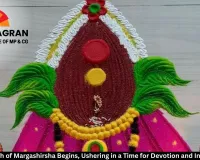Gauri Tapo Vrat on November 20, 2025: Embracing Renewal and Divine Grace on Amavasya
Digital Desk

As the crisp November breeze sweeps through India on November 18, 2025, hearts across the nation turn toward a sacred convergence of lunar cycles and spiritual devotion. Just two days away, on November 20, devotees prepare for Gauri Tapo Vrat, a poignant observance honoring Goddess Gauri (Parvati) that aligns with the Amavasya, or New Moon, in the Krishna Paksha of Agrahayana month.
This rare alignment infuses the ritual with profound energy for introspection, release, and rebirth, making it an ideal time for women to seek blessings for marital harmony, inner strength, and emotional healing.
Unlike the more festive five-day summer edition in Ashadha month, this November Gauri Tapo Vrat is a single-day immersion in quiet devotion, drawing from ancient Hindu traditions to foster personal transformation amid the year's end.
The roots of Gauri Tapo Vrat trace back to timeless mythology, where Goddess Parvati, embodying purity and unwavering love, undertook severe penance to unite with Lord Shiva. As narrated in the Skanda Purana, Parvati's tapasya—marked by fasting and meditation—symbolized the triumph of devotion over adversity, ultimately securing her divine marriage.
This tale inspires unmarried girls to observe the vrat for an ideal partner and married women for enduring spousal bliss and family prosperity.
On Amavasya, the day's inherent darkness amplifies themes of letting go of past burdens, much like the moon's renewal cycle. Astrologers note that 2025's planetary positions, with Saturn's grounding influence, enhance the vrat's potential for deep emotional purification and relational renewal.
In regions like Gujarat, Maharashtra, and parts of Uttar Pradesh, where Gauri worship thrives, preparations for November 20 are underway with a sense of serene anticipation. Homes buzz with the scent of fresh incense and the soft rustle of decorating altars with marigold garlands and clay lamps. "Observing Gauri Tapo Vrat on Amavasya feels like whispering secrets to the universe—it's intimate and powerful," shares Anjali Desai, a 25-year-old from Surat, who plans to participate for the third year.
Social platforms light up with #GauriTapoVrat2025 and #AmavasyaGrace, where users exchange virtual prasad recipes and mantra playlists, bridging generational traditions in the digital age. Temples such as Vadodara's Laxmi Vilas Palace shrine and Delhi's Parvati Mandir expect modest gatherings, emphasizing personal puja over crowds.
The rituals for Gauri Tapo Vrat on November 20, 2025, are elegantly simple, emphasizing heartfelt intent over elaborate displays, perfectly suited to the Amavasya's contemplative mood.
Devotees awaken before dawn for a cleansing bath in holy water if possible, slipping into pristine white or green attire to channel Gauri's serene essence. The fast is nirjala (waterless) until afternoon for the devout, or partial with sattvic foods like bananas, milk, and honey-sweetened kheer—strictly sans salt to symbolize purging negativity.
Sunrise marks the sankalpa, or vow-taking, where one sits before a modest altar featuring a silver or clay image of Goddess Gauri, flanked by betel leaves, kumkum tilak, and seasonal fruits like pomegranates for fertility.
Light a ghee diya to dispel inner shadows, and offer rice grains while chanting the potent Gauri Mantra: "Om Aim Hreem Kleem Chamundayai Vicche Namah," repeated 108 times with a rudraksha mala for amplified vibrations.
For those incorporating the symbolic Ankura Vidhi, barley seeds sown a few days prior are now tender sprouts, harvested as offerings to represent budding hopes and life's quiet growth even in obscurity.
Midday meditation focuses on Parvati's katha, recited aloud or silently, invoking her protective aura for relational peace. As evening approaches, the Pradosh window—roughly 5:45 PM to 7:50 PM—ushers in the climax with an aarti to Shiva-Gauri, using camphor flames to illuminate intentions.
Devotees tie a sacred thread (moli) around the wrist, vowing fidelity to their aspirations. The vrat concludes post-sunset with parayushan—a shared meal of salted roti and yogurt—distributed as prasad to family and neighbors, fostering communal bonds.
Health-wise, this fruit-centric fast aids detoxification, boosting immunity as winter looms, while the meditative practice eases monsoon-after stress.
Beyond personal piety, Gauri Tapo Vrat on November 20, 2025, weaves into broader cultural threads. In rural Gujarat, folk ballads retell Parvati's saga under starlit skies, while urban wellness circles host online sessions blending yoga asanas with Gauri bhajans.
Numerologists highlight the date's "renewal vibration," aligning with Amavasya's cosmic reset for manifesting 2026's joys. For newcomers, starting with just the evening puja invites subtle shifts—clarity in love, resilience in trials.
As November 20, 2025, dawns, Gauri Tapo Vrat stands as a luminous thread in Hinduism's tapestry, reminding us that even in darkness, divine light awaits the devoted heart.
It's more than a fast; it's a portal to grace, urging women to claim their power through Parvati's eternal wisdom. Light your inner diya, embrace the New Moon's hush, and let Gauri's blessings bloom anew.
In a world of fleeting connections, this vrat affirms: true harmony is sown in silence, harvested in faith.






.jpg)




